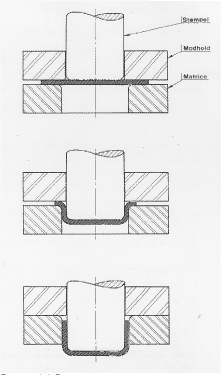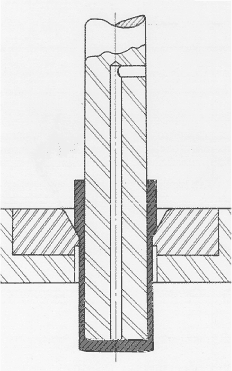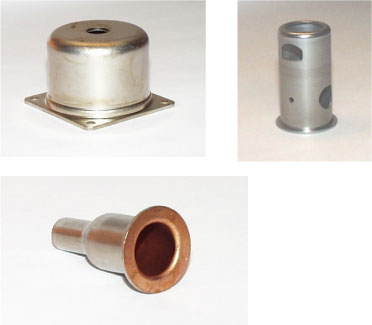|
Mapping and development of alternatives to chlorinated lubricants in the metal industry (KLORPARAFRI) 2 Metalworking – processes, materials and lubricants
2.1 Introduction to chapter 2The objective of chapter 2 is to give a short introduction of both the metal working processes in focus in this project and the lubricant formulation including the present status of lubricant technology for heavy-duty metal working. 2.2 Processes and materialsMetalworking processes are normally separated into two main types, chip removing (cutting) operations and chip-less (forming) operations. Chip removing operations include milling, threading and drilling. Chip-less operations are subdivided into sheet- and cold forging operations. Sheet metal forming involves operations such as punching and deep drawing. Relevant cold forging operations in this project are extrusion and backwards can extrusion. This project focuses on chip-less machining of metallic materials and especially on sheet forming operations. Thus, lubricants developed for sheet forming operations are the principal interest in this project. However, if lubricants developed for cold forging operations show properties, which might contribute positively to lubrication in sheet forming operations, they will be included in the project. Danfoss A/S, a large Danish company, participates in this project as the metal industry partner. Production tests of selected lubricants, described in chapter 5, are performed at Danfoss A/S. The metal working operations at Danfoss A/S, where chlorinated lubricants are used at present, are forming operations in stainless steel including:
The forming processes may include combinations of the mentioned operations. The three types of forming operations are briefly described below. In sheet metal forming, cutting intended for creating a controlled break in the material, is the process most often used. Punching which is a process, where holes of different shapes are made in the blank is an example of a metal forming process including cutting (see figure 2.1). Deep drawing is defined as a pull-pressure forming of a plane sheet to a hollow body, or a hollow body changing shape to a hollow body of a smaller circumference without changing the thickness of the sheet (see figure 2.2). Extrusion is a cold forging process where the body is severely deformed during great heat generation. An example of extrusion is shown in figure 2.3 where a cup is formed with reduced wall thickness. Figures 2.1, 2.2 and 2.3 illustrate the three forming operations. 
Figure 2.1 Sequence of punching: 1. Punch, 2. Sheet, 3. Support 
Figure 2.2 Deep drawing 
Figure 2.3 Extrusion Materials for which chlorinated paraffins are required at Danfoss A/S in the forming operations are:
Figure 2.4 and 2.5 shows work pieces produced by Danfoss A/S. In the production process of these work pieces chlorinated lubricants are required. The shown work pieces and the forming operations are representative of the use of chlorinated lubricants. To a less extent more extreme deep drawing, extrusions and punching forming operations are also conducted. 
Figure 2.4 Deep drawing in several steps with slight extrusion in final step. Performed in a multistage deep drawing including slight extrusion in the last step. Produced in a step press. 0,8 mm stainless steel (W.nr. 1.4306) 
Figure 2.5 The three work pieces are made in a step press at Danfoss A/S with up to seven draws and a final calibration (extrusion to final thickness of material). The materials are stainless steel (W.nr. 1.4301), acid resistant steel (W.nr. 1.4404), and a copper coated acid resistant steel ((W.nr. 1.4404 / Cu). The forming operations in focus in this project are divided in the following groups: A1 Deep drawing of highly alloyed steel (>4% Cr) B1 Punching of sheets of highly alloyed steel (>4% Cr) 2.3 Lubricants2.3.1 Traditional formulation of lubricants for chip-less manufacturingThe traditional lubricants for use in chip-less processing of metals are normally based on mineral oil, polar additives and so-called extreme pressure (EP) additives. EP additives in the lubricant prevents sliding metal surfaces from seizing under conditions of extreme pressure. At the high local temperatures associated with metal-to-metal contact, an EP additive combines chemically with the metal to form a surface film that prevents the welding of opposing asperities and the consequent scoring that is destructive to sliding surfaces under high loads (10). Other additives may also be present in the lubricant such as biocides, de-foamers, yellow metal inhibitors etc.. However, these additives do not contribute to the lubricating properties of the formulation. The lubricants are most often used as straight oils (oil based wet lubricants). However, water-miscible formulations (water miscible wet lubricants) and dry-film lubricants (dry lubricants), which are applied in wet form and dried up as a solid film before processing of the metal, are also seen in industrial applications. The traditional lubricants for chip-less manufacturing usually consist of the following components:
The below-mentioned parameters are particularly important in the design of the qualities of the finished lubricant.
2.4 Metal forming and lubricants – technical development2.4.1 Problems when replacing chlorinated paraffinsWhen replacing chlorinated paraffins, the following problems are particularly encountered:
One of the basic problems encountered when replacing chlorinated paraffins is thus connected to their ”multi-functionality” which cannot be found in any other EP additive. Instead of using a single EP additive, the formulator is often forced to choose a “package” of lubrication additives. Doing so, the finished lubricant becomes much more complex than a traditional chlorinated lubricant. Naturally, this causes increased expenses and subsequently problems when selling the products on a market where the use of chlorinated paraffins is not directly banned. Another problem is to document the technical properties of an alternative lubricant to the customers. There is a lack of standardised lubricating test methods where results from laboratory testing can be correlated with full-scaled production trials. 2.4.2 Present statusParticularly in Western Europe, the producers of lubricants have worked intensively to replace chlorinated paraffins in metal working lubricants. This has been a success in most lubricants for cutting processing of ordinary steel, copper, brass and aluminium and less demanding chip-less metal forming processes. However, until today, it has been problematic to find technically satisfying alternatives to chlorinated paraffins, for instance demanding chip-less processing of stainless steel and titanium. Non-chlorinated lubricant alternatives using new formulation technologies such as inorganic fillers and polymers are now on the market. However, these products are often developed for one particular process and one particular client. Thus, the supply of products is huge and an overall view of non-chlorinated lubricant alternatives is not possible. In addition, testing of new chlorine-free lubricants is costly for the metalworking companies as it implies breaking off in production, possibly repairs of tools due to breakdown of the test lubricant, and increased scrap percentage of the final work pieces. Subsequently, this leads to downtime and increased costs. Thus, there is still a substantial need for development of new non-chlorinated lubricant alternatives, especially for heavy-duty metal forming operations which are universal, reliable, economic, and possible to use in the existing production lines without major modifications of the technical equipment.
|